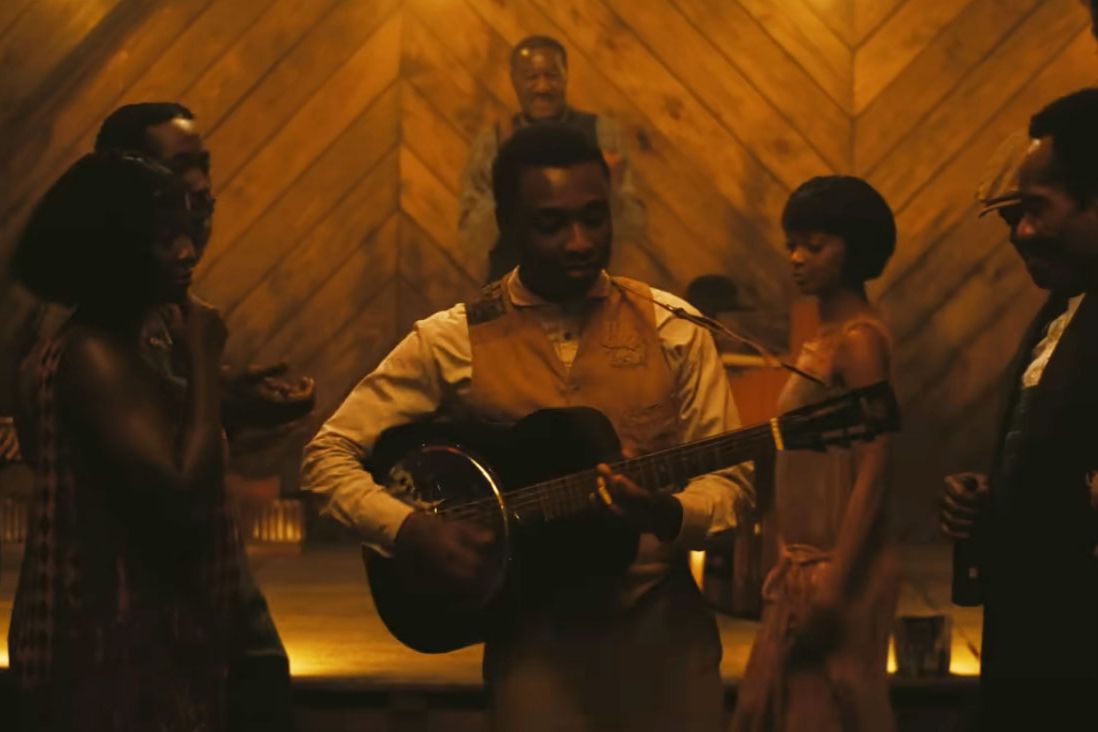

Ryan Coogler’s Sinners flexes a modern disregard for categorization, exploring the ghastly inequities of the Jim Crow South through luridly competing genre lenses. On one level, it’s a vampire flick reverent to the sights and principles of its predecessors: The smoldering introduction of Celtic folkie and main antagonist Remmick (Jack O’Connell) resembles a sun scorching in 1987’s Near Dark; the defense of a Mississippi juke joint from the Klan and the vamps adds a twist to the saloon showdown from 1996’s From Dusk Till Dawn; the villains’ zesty musical number imagines an early-20th-century predecessor to the Lestat concert from 2002’s Queen of the Damned. All the while, the new film depicts an alternate account of the journey of Delta blues players, whose guitar innovations inspired folk and rock legends. Treating the haints and zombies stalking the edges of the southern Christian consciousness not just as vestiges of Black religiosity before slavery but as secret sects still molding culture, Sinners raises a simple question: What if literal bloodsuckers had infested the predatory music industry, leeching ideas and techniques off Black prodigies?
Coogler’s villains are white songcatchers who stumble onto the joint and rapidly grasp the future cultural resonance of the acoustic chops the film’s lead, Sammie (Miles Caton), is honing. His father beckons to a life of faith, but his cousins Smoke and Stack (twin Michaels B. Jordan) have returned from a Capone operation looking to launder money and recruit the young performer for their juke joint’s band. The vampires’ goal is not just to tap jugulars; they offer to take the fear of death off the table for the downtrodden Delta dreamers in exchange for a taste of the local culture, to trade telepathy and superhuman strength for access to the blues. This already feels fresh, deeper in anthropological accuracy and concern than horror films interested in guitar music tend to dig.
The fang gang present themselves as yearning European folk enthusiasts and later as jigging fiends and sometime metalheads. Meanwhile, the juke joint is pregnant with the future of soul, funk, hip-hop, and electronic music. The encroachment of the former party on the latter mirrors the plight of notable blues guitarists of the mid-20th century. Sammie feels like a clever composite of Robert Johnson, who is famously rumored to have cut a bargain with the devil for his skills; John Lee Hooker, whose sharecropper-pastor father resented his instrument; and Muddy Waters, whose labels goaded him into muted playing styles to cater to wider (and whiter) audiences. The film slowly ditches the care with which its diorama of ’30s farmers, grocers, and Chitlin’ Circuit would-bes was assembled to bring them in contact with the unattributed musical borrowing and dippy togetherness of the ’60s; the vamps’ offer imagines a begging for the keys to the kingdom of rock and roll taking place ahead of the pilfering. Sammie can submit to jumpy European undead aching for soul power, quit and serve a congregation, or cut his own path. (A late cameo from 88-year-old sharecropper turned blues titan Buddy Guy as the successful elder version of the protagonist loudly endorses the third road.)
Inside the juke joint, Sinners hazards a guess at what a son of the morning might want from a talented up-and-coming shredder. The underlying argument that music is a force on par with the holy and unholy factions vying for Sammie’s allegiance is foregrounded as he plays “I Lied to You,” a jam so intense that time shatters and the music of the past and present wafts through the venue. Sinners interrupts its own plot to express that the spirit of African griots will continue to take new shapes in centuries to come. Blues guitars meet reverb-drenched 808s; G-funk synth licks drape over echoing reggae riffs in the first collaboration between the R&B singer-songwriter Raphael Saadiq and Metallica drummer Lars Ulrich. Onscreen, Coogler parades twerkers, DJs, and dancers from across time through the club. Music seizes the reins and detonates the studied historicity viewers expect from stories about 20th-century music, pausing to highlight points the reader normally catches in articles about a movie rather than scenes in it: Yes, the blues begat both DOOM and doom.
Sammie’s performance feels like a breakthrough between Coogler and his longtime musical cohort Ludwig Göransson, who’s been a presence in each of the director’s films since Fruitvale Station. Göransson was the producer behind the twee plushness of early Childish Gambino records; complementary interests in hip-hop, musicology, and orchestration informed his work for Black Panther. Crucially, he is also a guitarist often too busy scoring films to shred. “Lied” weaponizes these predilections as well as the preternaturally gifted Caton, whose voice seems twice as old as his body. The song borders on the absurd, but its faith in the metaphysical properties of a melody is infectious. Like a Cowboy Carter allotted just five minutes to make a case for the vast reach of the guitar, Sinners stresses that the boundary-immolating power of music is not just sufficient to pique the interest of these creatures of the night but to shake you out of any idea where the thing you’re watching was heading.
Related

Latest News
For Sale! 2016 Sea Ray 350 Sundancer – $180,000
Reel Deal Yacht is pleased to feature a meticulously maintained 2016 Sea...
The Future of Fine Jewelry Is Kind: How Friendly Diamonds Is Transforming Sustainable Luxury
The Rise of Conscious Luxury: How Friendly Diamonds is Redefining Jewelry In...
The Controversial Story Behind Kristi Noem’s $50 Million Luxury Jet
The Controversy Surrounding Kristi Noem’s Proposed Luxury Jet Kristi Noem, President Donald...
Which collectible blind box do you prefer?
The Adorable World of Labubu and Smiski: A Collector’s Delight When it...
Emma Thompson to Host Jane Austen Event at Upscale Hampshire Hotel
Emma Thompson Hosts Special Screening of Sense and Sensibility at Heckfield Place...













